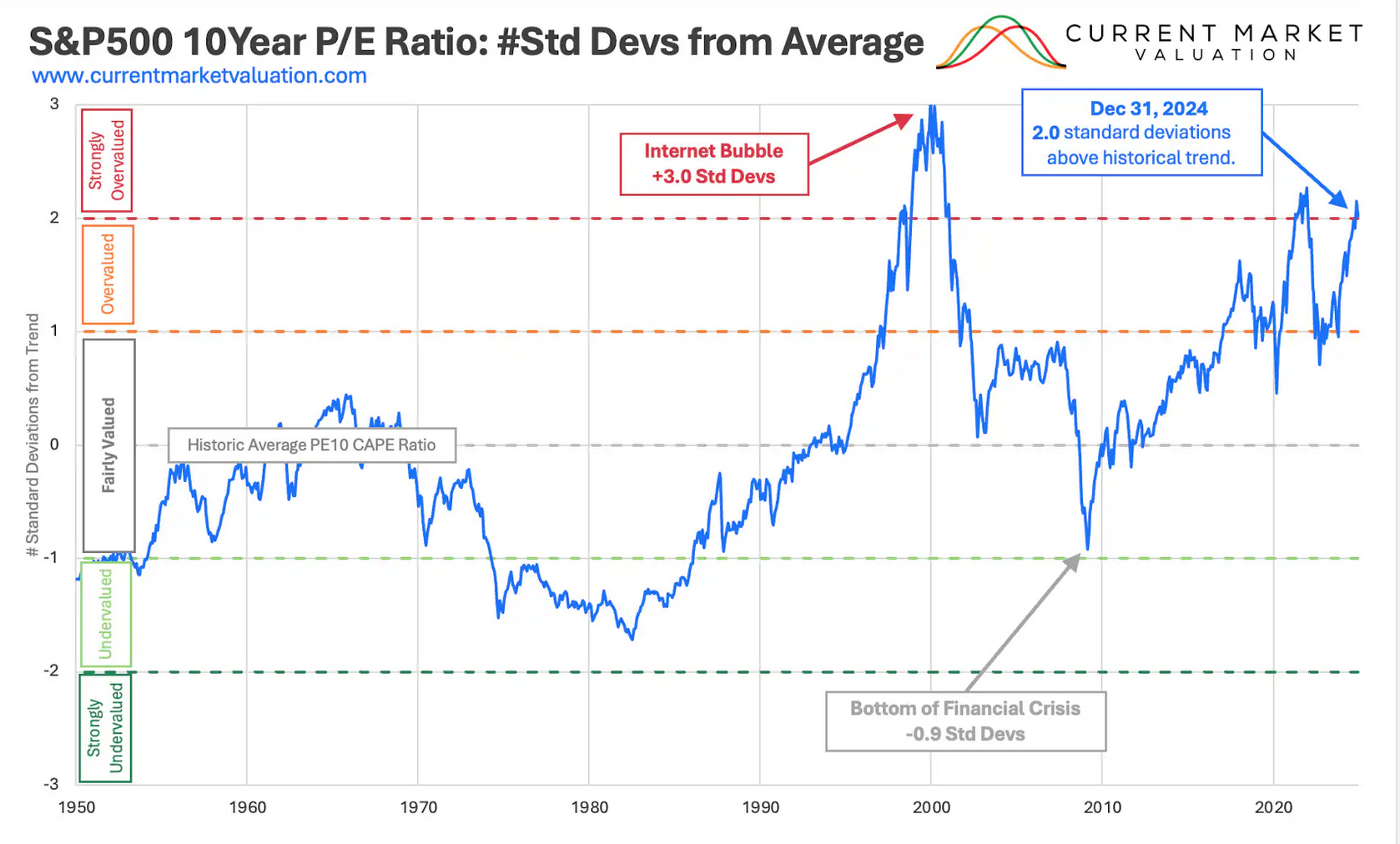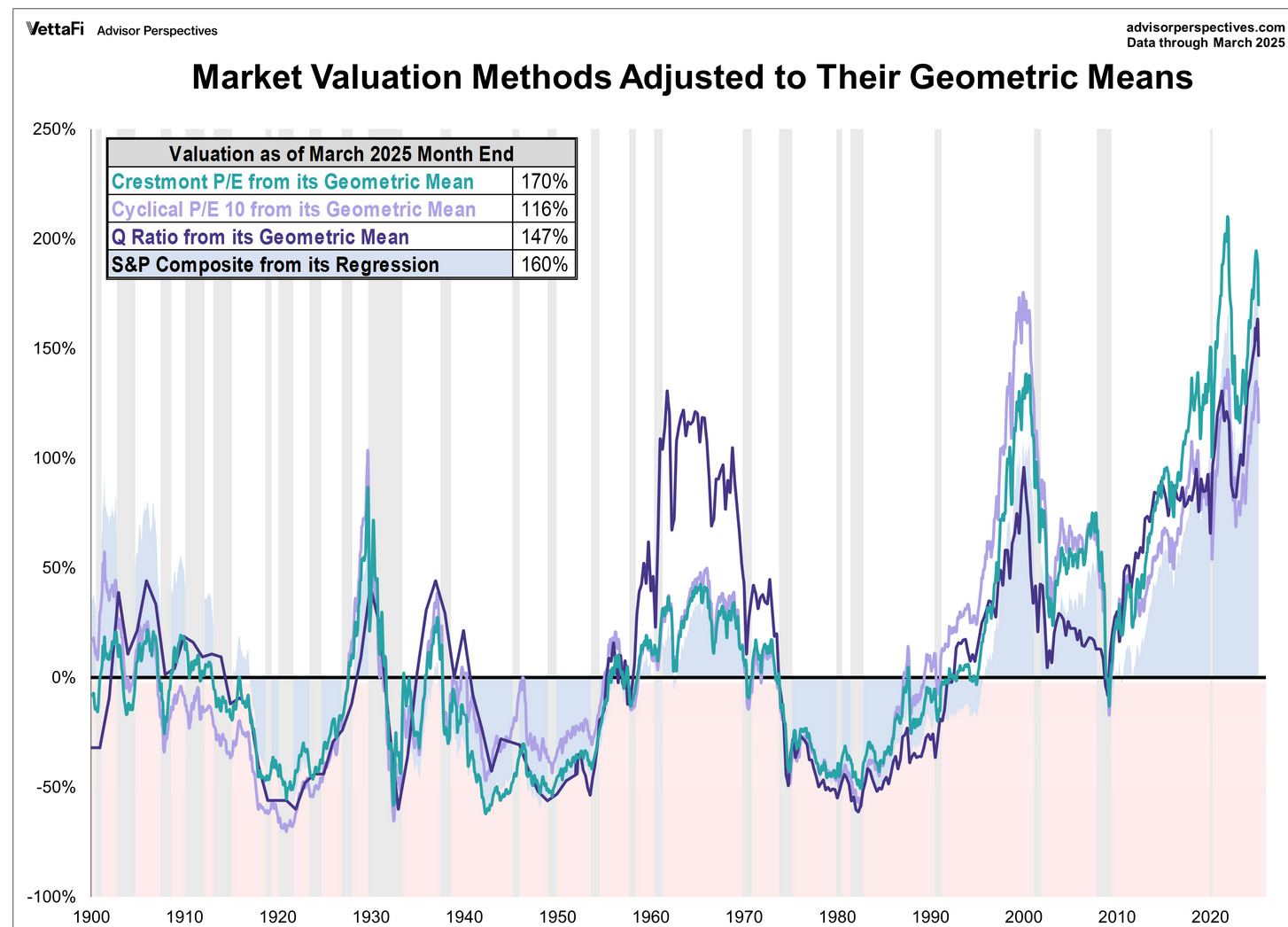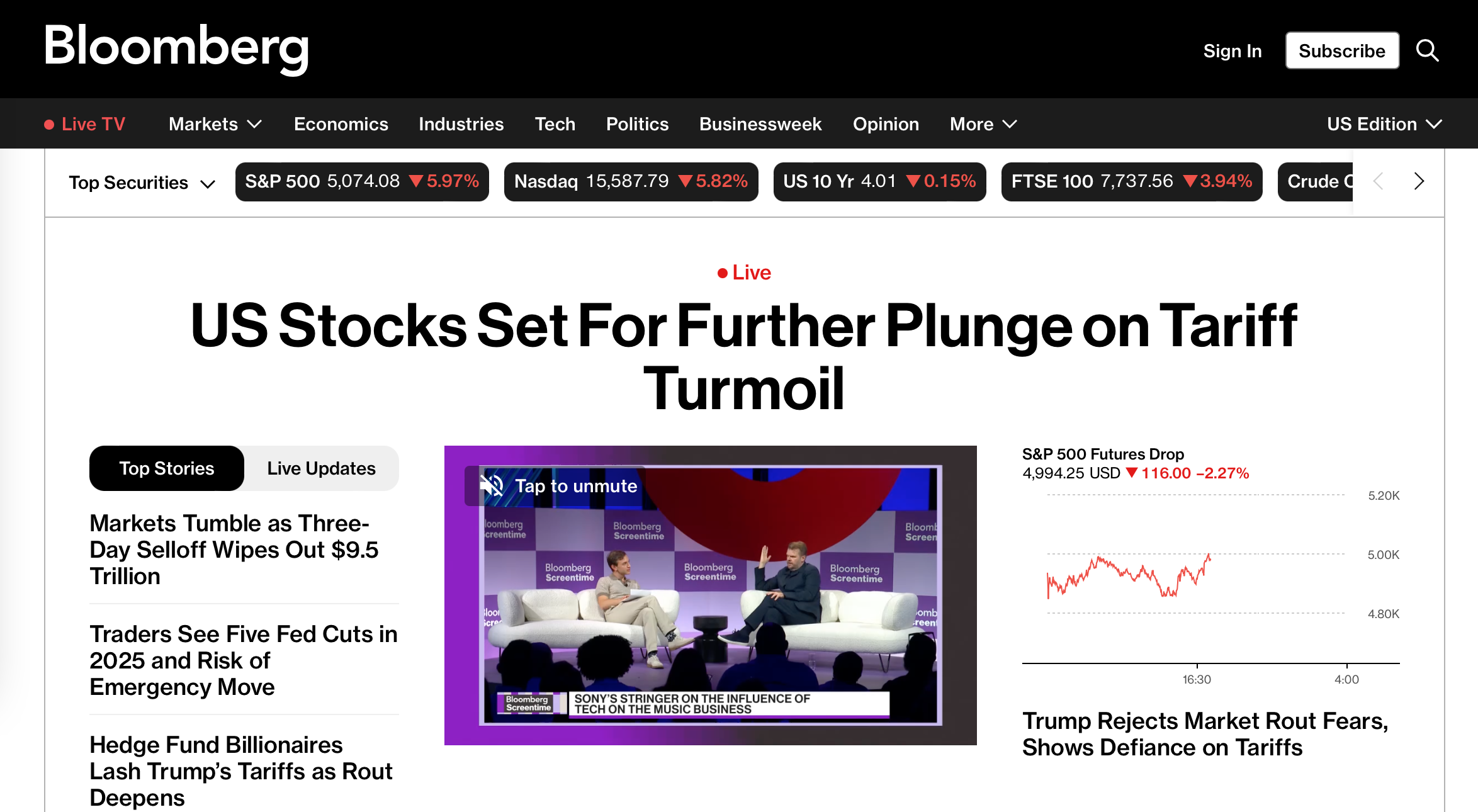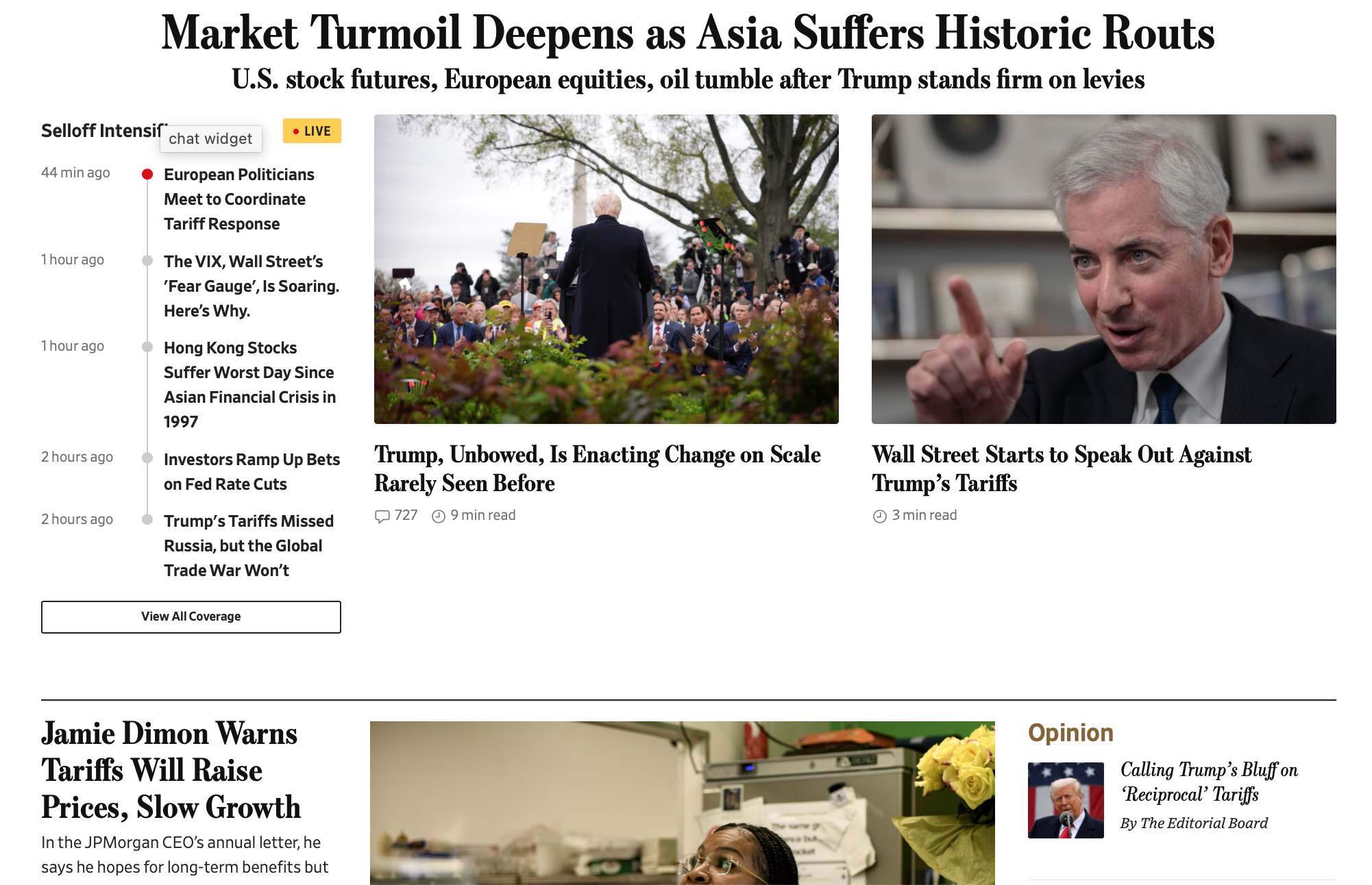It is perverse but predictable that the media is fixated on the drama of a global equity and risk assets rout, and is less attentive to the likely depth of the coming real economy damage. We will shortly turn to the fact that the freakout of late last week intensified after Treasury Secretary Scott Bessent doubled down on how the Trump Administration was not retreating from its shock and awe tariffs, throwing in the insult to intelligence of trying to depict the US as victim of so-called free trade deals and a liberalized trade regime it had promoted.
The bad substantive part of Bessent’s blather was that even if other countries made trade concessions that the US found acceptable, it would take months (at best) to iron out details. Trump did his version of Nero fiddling by playing golf and posting to Truth Social.
The same way the meal is not the menu, even more so, securities markets are not the economy. But you’d never know that looking at the lead headline at the New York Times:
And as reader spud pointed out in comments, even putative defenders of workers seem to have over time been brainwashed:
gee i wonder if it has anything to do with bill clinton sending americas real wealth offshore so that the stock market could end up being the largest economic bubble in the history of the world, you gotta wonder.
and during trumps first term nancy pelosi stood up in front of america and declared democrats are free traders to their core.
so now a tiny few own more than the rest of us combined, control americas political system, and what do we hear out of the whiners, gee look at all of those losses in the stock market.
“The US would need 5 years of the income from tariffs at this new level to equal the $2 trillion wiped out in today’s stock market loss.
US only has $4.1 trillion in annual imports.”
even jimmy dore and jamie galbraith are whining about stock market losses.
read the comments, it tells the story.
[embedded content]
lori wallach,
[embedded content]
comments mostly great.
One of the disturbing developments has been central bank obsession, fostered by Alan Greenspan, with stock price levels. That in turn produced the famed Greenspan, and later Bernanke and Yellen puts, the way the Fed would run in to engage in aggressive rate cuts to boost stock prices. The predictability of that behavior reduced the riskiness of stock market investment by truncating the downside, encouraging investors to be more complacent about equity market risk than they ought to be.
On top of that, stock prices have become more and more unmoored from the real economy. We described long form in 2005 (yes, 20 years ago) in the Conference Board Review how public corporations in the US had, on the whole, moved to the unnatural and economically counter-productive behavior of net saving, as in slowly liquidating. A savvy friend remarked around that time, “Why should I invest in a stock when its management isn’t investing in the business?” Yet investors have been conditioned to do just that via stock buybacks and short-termist cost fixation. The end of that road is the wrecking of once great companies like Boeing and Intel.
As you can see from the valuation charts below, the Fed getting out of ZIRP did not lead to a major reset, when investors ought to require higher returns from stocks in a higher interest rate regime. See:
Current Valuation:
GuruFocus (series ends at October 1, 2024; its value in February reached 1.97):
Advisor Perspectives
Cison on March 25, argued the market was considerably overvalued:
The Buffett Indicator, which compares the total market value to U.S. GDP, currently sits at 211%. This ratio is calculated by dividing the Total Value of the stock market $62.29 Trillion by the total GDP $29.55 Trillion. This indictor currently sits art approximately 66.99% above the historical trend line, indicating the stock market may be “strongly overvalued” relative to the size of the U.S. economy.
That is not to say that the investments swan dive won’t hurt the Confidence Fairy and so also have real economy effects. But the Fed has been attentive to the wealth effect, and has concluded that it’s about 3 times as large for housing as it is for stocks.
Since a lot more will happen as the US markets open and the business day begins, we thought headlines would give a good snapshot of the current state of play:
FT Alphaville has an excellent chart series on action, or more accurately, heart attacks, in various markets.
This overly dynamic situation is giving cover to the DOGE teardown at Social Security, which will do enormous damage to individuals and the economy. This pillage will directly lead to Russia-in-the-1990s level outcomes, like the elderly begging outside churches as the froze or starved to death. A critically important point is Social Security is well on its way to being wrecked now, even before getting the DOGE plan to finish the job via the pretext of re-doing a perfectly functional massive database and related systems. From the Guardian in Doge’s attack on social security causing ‘complete, utter chaos’, staff says:
Office closures, staffing and service cuts, and policy changes at the Social Security Administration (SSA) have caused “complete, utter chaos” and are threatening to send the agency into a “death spiral”, according to workers at the agency…
“They have these ‘concepts of plans’ that they’re hoping are sticking but in reality, are really hurting American people,” said a longtime SSA employee and military veteran who requested to remain anonymous for fear of retaliation. “No one knows what’s going on. They’re just coming up with ideas at the top of their head.”
The SSA website has crashed several times this month. Wired reported Doge staff want to migrate all social security data and rewrite code in months, which could cause system collapse and further outages.
The agency plans to eliminate the jobs of 7,000 workers at the agency through voluntary buyouts, resignations or firings, though the union representing SSA employees anticipate even more firings beyond cutting staff to 50,000 workers…
“It’s just been a lot of craziness, a lot of foolishness. Until they get rid of Doge and the person in office right now, and the Republicans actually get a backbone and stand up for something for once in their lives, things are just going to be complete chaos. That’s really the best word to describe SSA right now, just complete, utter chaos,” the worker added. “They couldn’t understand the coding, so everything they said SSA was doing illegally, they weren’t. Common sense is something they lack. They don’t know what they’re doing.”
Rich Couture, a spokesman for the American Federation of Government Employees’ Social Security Administration general committee, the union representing roughly 42,000 social security workers, said Doge’s public targets for cuts make no sense.
Why are they cutting 7,000 jobs, asked Couture….
“I don’t think they’re going to stop at 7,000 people lost. If they lose 10,000 or 12,000, they’re running up their high score. They’re able to brag about it.”
Departments at the agency have been closed and reorganized, with workers forced to take reassignments or risk firings, and all workers have been ordered to return to the office five days a week…
“There is no safe office in this country,” added Couture. “It’s a concerted attack on the legitimacy of social security itself. The promise that this country has made to the public with respect to income security is being broken.”…
Couture noted the operating overhead of the agency, as a share of benefits paid out, has shrunk by 20% over the last ten years and is now less than 1%…..claiming the agency is already a model of efficiency and as effective as possible under its fiscal and staffing constraints.
He said he was concerned the situation was creating a “negative feedback loop” where, as more employees leave, more work is put on those remaining, depressing morale and inducing more to leave “until the agency ends up in a death spiral with staffing, inducing office closures”.
We are doing our part in trying to keep the focus on real economy effects, such as with our companion article today on how the Trump tariffs will harm auto industry production and employment and greatly raise costs without producing meaningful US reindustralization.
When Pinochet implemented the Chicago Boys’ radical neoliberal program, Chile at least got an initial asset bubble before the train wreck started. Pinochet not only abandoned most of his reforms but engaged in Keynesian backpedaling and restored union rights.
Even though there’s no evidence of upside here (say unless you were a hedgie or currency trader who got advanced wind of the severity of Trump action), even if Trump were to reverse course quickly, it’s not clear how much of his DOGE and tariff destruction could be unwound. Which no doubt is the point.








